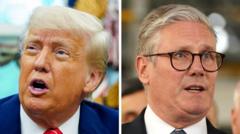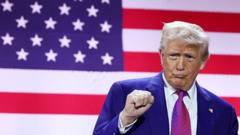The latest agreement between the US and UK, which aims to alleviate some of the tariffs imposed by President Trump, has sparked varied reactions among stakeholders, revealing both optimism and concerns about its long-term implications.
US and UK Forge New Trade Agreement Easing Tariffs on Vehicles and Metals

US and UK Forge New Trade Agreement Easing Tariffs on Vehicles and Metals
The US and UK have reached a significant trade deal that reduces tariffs on certain British cars and metals, bringing relief to key industries.
With the backdrop of a fluctuating trade relationship, the United States has entered into a new trade agreement with the United Kingdom that will lower import tariffs on a limited number of British cars and grant tariff-free access for select steel and aluminum products. This development comes as a welcome reprieve for crucial sectors in the UK that have been impacted by heightened duties post-Trump’s inauguration earlier this year.
The deal, announced but not formalized on Thursday, still leaves in place a 10% tariff on most goods, a factor that some analysts suggest may not radically change the existing trade dynamics between the two nations, as they stood before the recent shifts. At a press event held at a Jaguar Land Rover facility in the West Midlands, UK Labour Party leader Sir Keir Starmer hailed the agreement as a "fantastic platform," emphasizing its potential to protect jobs within the car manufacturing and steel sectors. Starmer further asserted that the UK’s alliance with the US was stronger than ever.
President Trump, commenting on the agreement, praised it as a "great deal" and suggested it would lead to even more expansive developments in the future. According to the terms of the deal, tariffs on 100,000 British cars will be reduced from 25% to 10%, benefitting luxury vehicle manufacturers, although this number aligns closely with the exports seen in the previous year, thus potentially limiting future growth.
In discussions surrounding the new tariff scheme, UK Business Secretary Jonathan Reynolds remarked on the urgency surrounding the negotiations, asserting that without this breakthrough, thousands of jobs in the car industry could have been jeopardized.
Additionally, the updated agreement sees the US re-establishing a quota system on steel and aluminum imports that mirrors previous arrangements. Excitingly, both countries have come to agree on allowing up to 13,000 metric tonnes of beef imports from each other, a notable increase from previous caps, thereby aiming to facilitate smoother agricultural trade.
While the agreement presents a $5 billion economic opportunity for trade, including sectors like ethanol and agriculture, opinions vary among stakeholders. Gareth Stace, Director General of UK Steel, welcomed the changes as relief for the sector, whereas others, like Duncan Edwards of BritishAmerican Business, noted that while improvements had occurred, the overall situation hadn’t dramatically benefitted compared to earlier in the negotiations.
Responses from opposition parties in the UK have highlighted the need for additional scrutiny of the deal’s details, with some MPs calling for parliamentary votes to ensure public oversight. Conservative Party leader Kemi Badenoch criticized the terms, suggesting the UK faced a losing position in negotiations.
As the US and UK continue to navigate intricate trade dynamics, uncertainty lingers around the future of specific issues like pharmaceutical tariffs and food standards. With these negotiations still in flux, stakeholders will be keenly monitoring the implications that may arise from this latest agreement.
The deal, announced but not formalized on Thursday, still leaves in place a 10% tariff on most goods, a factor that some analysts suggest may not radically change the existing trade dynamics between the two nations, as they stood before the recent shifts. At a press event held at a Jaguar Land Rover facility in the West Midlands, UK Labour Party leader Sir Keir Starmer hailed the agreement as a "fantastic platform," emphasizing its potential to protect jobs within the car manufacturing and steel sectors. Starmer further asserted that the UK’s alliance with the US was stronger than ever.
President Trump, commenting on the agreement, praised it as a "great deal" and suggested it would lead to even more expansive developments in the future. According to the terms of the deal, tariffs on 100,000 British cars will be reduced from 25% to 10%, benefitting luxury vehicle manufacturers, although this number aligns closely with the exports seen in the previous year, thus potentially limiting future growth.
In discussions surrounding the new tariff scheme, UK Business Secretary Jonathan Reynolds remarked on the urgency surrounding the negotiations, asserting that without this breakthrough, thousands of jobs in the car industry could have been jeopardized.
Additionally, the updated agreement sees the US re-establishing a quota system on steel and aluminum imports that mirrors previous arrangements. Excitingly, both countries have come to agree on allowing up to 13,000 metric tonnes of beef imports from each other, a notable increase from previous caps, thereby aiming to facilitate smoother agricultural trade.
While the agreement presents a $5 billion economic opportunity for trade, including sectors like ethanol and agriculture, opinions vary among stakeholders. Gareth Stace, Director General of UK Steel, welcomed the changes as relief for the sector, whereas others, like Duncan Edwards of BritishAmerican Business, noted that while improvements had occurred, the overall situation hadn’t dramatically benefitted compared to earlier in the negotiations.
Responses from opposition parties in the UK have highlighted the need for additional scrutiny of the deal’s details, with some MPs calling for parliamentary votes to ensure public oversight. Conservative Party leader Kemi Badenoch criticized the terms, suggesting the UK faced a losing position in negotiations.
As the US and UK continue to navigate intricate trade dynamics, uncertainty lingers around the future of specific issues like pharmaceutical tariffs and food standards. With these negotiations still in flux, stakeholders will be keenly monitoring the implications that may arise from this latest agreement.





















